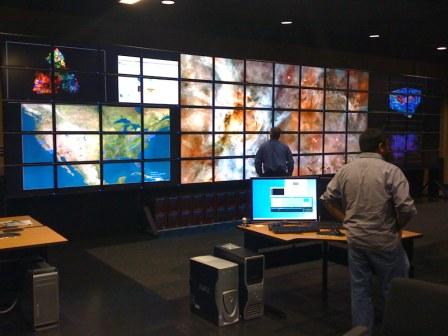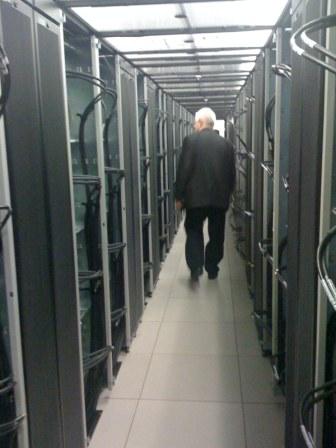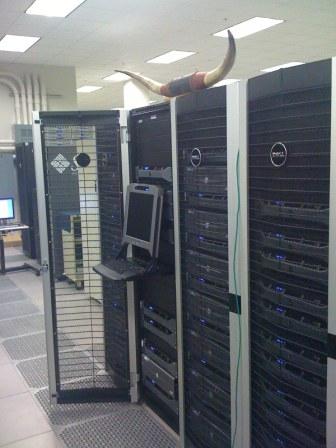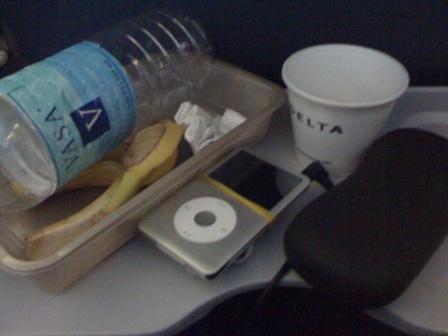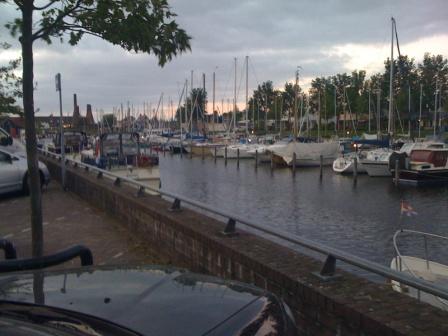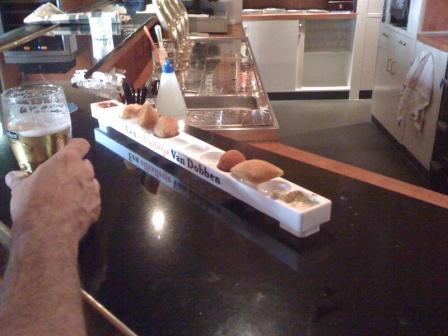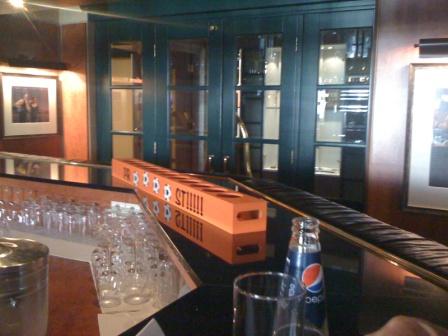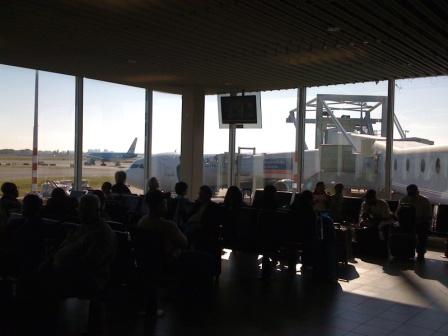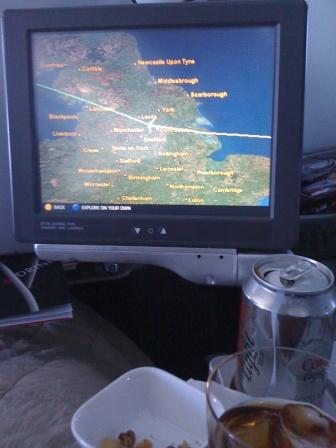Ok, it’s now official, following its debut at the VMworld 2011 book store last week in Las Vegas, my new book Cloud and Virtual Data Storage Networking (CRC Press) is now formally released with general availability announced today along with companion material located at https://storageioblog.com/book3 including the Cloud and Virtual Data Storage Networking LinkedIn group page launched a few months ago. Cloud and Virtual Data Storage Networking (CVDSN) a 370 page hard cover print is my third solo book that follows The Green and Virtual Data Center (CRC Press 2009) and Resilient Storage Networks (Elsevier 2004).

CVDSN book was on display at VMworld 2011 book store last week along with a new book by Duncan Epping (aka @DuncanYB ) and Frank Denneman (aka @frankdenneman ) titled VMware vSphere 5 Clustering Technical Deepdive. You can get your copy of Duncan and Franks new book on Amazon here.

Here is a photo of me on the left visiting a VMworld 2011 attendee in the VMworld book store.
Whats inside the book, theme and topics covered
When it comes to clouds, virtualization, converged and dynamic infrastructures Dont be scared however do look before you leap to be be prepared including doing your homework.
What this means is that you should do your homework, prepare, learn, and get involved with proof of concepts (POCs) and training to build the momentum and success to continue an ongoing IT journey. Identify where clouds, virtualization and data storage networking technologies and techniques compliment and enable your journey to efficient, effective and productive optimized IT services delivery.
There is no such thing as a data or information recession: Do more with what you have
A common challenge in many organizations is exploding data growth along with associated management tasks and constraints, including budgets, staffing, time, physical facilities, floor space, and power and cooling. IT clouds and dynamic infrastructure environments enable flexible, efficient and optimized, cost-effective and productive services delivery. The amount of data being generated, processed, and stored continues to grow, a trend that does not appear to be changing in the future. Even during the recent economic crisis, there has been no slow down or information recession. Instead, the need to process, move, and store data has only increased, in fact both people and data are living longer. CVDSN presents options, technologies, best practices and strategies for enabling IT organizations looking to do more with what they have while supporting growth along with new services without compromising on cost or QoS delivery (see figure below).
Driving Return on Innovation the new ROI: Doing more, reducing costs while boosting productivity
Expanding focus from efficiency and optimization to effectiveness and productivity
A primary tenant of a cloud and virtualized environment is to support growing demand in a cost-effective manner with increased agility without compromising QoS. By removing complexity and enabling agility, information services can be delivered in a timely manner to meet changing business needs.
There are many types of information services delivery model options
Various types of information services delivery modes should be combined to meet various needs and requirements. These complimentary service delivery options and descriptive terms include cloud, virtual and data storage network enabled environments. These include dynamic Infrastructure, Public & Private and Hybrid Cloud, abstracted, multi-tenant, capacity on demand, Infrastructure as a Service (IaaS), Platform as a Service (PaaS), and Software as a Service (SaaS) among others.
Convergence combing different technology domains and skill sets
Components of a cloud and virtual environment include desktop, servers, and storage, networking, hardware, and software, services along with APIs and software stacks. This include virtual and physical desktops, data, voice and storage networks, LANs, SANs, MANs, WANs, faster blade and rack servers with more memory, SSD and high-capacity storage and associated virtualization tools and management software. True convergence combines leveraging technology and people, processes and best practices aligned to make the most of those resources to deliver cost-effective services delivery.
Best people, processes, practices and products (the four Ps)
Bringing all the various components together is the Ps (people skill sets, process, practices and products). This means leveraging and enhancing people skill sets and experience, process and procedures to optimize workflow for streamlined service orchestration, practices and policies to be more effectively reducing waste without causing new bottlenecks, and products such as racks, stacks, hardware, software, and managed or cloud services.
Service categories and catalogs, templates SLO and SLA alignment
Establishing service categories aligned to known service levels and costs enables resources to be aligned to applicable SLO and SLA requirements. Leveraging service templates and defined policies can enable automation and rapid provisioning of resources including self-service requests.
Navigating to effective IT services delivery: Metrics, measurements and E2E management
You cannot effectively manage what you do not know about; likewise, without situational awareness or navigation tools, you are flying blind. E2E (End to End) tools can provide monitoring and usage metrics for reporting and accounting, including enabling comparison with other environments. Metrics include customer service satisfaction, SLO and SLAs, QoS, performance, availability and costs to service delivered.
The importance of data protection for virtual, cloud and physical environments
Clouds and virtualization are important tools and technologies for protecting existing consolidated or converged as well as traditional environments. Likewise, virtual and cloud environments or data placed there also need to be protected. Now is the time to rethink and modernize your data protection strategy to be more effective, protecting, preserving and serving more data for longer periods of time with less complexity and cost.
Packing smart and effectively for your journey: Data footprint reduction (DFR)
Reducing your data footprint impact leveraging data footprint reduction (DFR) techniques, technologies and best practices is important for enabling an optimized, efficient and effective IT services delivery environment. Reducing your data footprint is enabled with clouds and virtualization providing a means and mechanism for archiving inactive data and for transparently moving it. On the other hand, moving to a cloud and virtualized environment to do more with what you have is enhanced by reducing the impact of your data footprint. The ABCDs of data footprint reduction include Archiving, Backup modernization, Compression and consolidation, Data management and dedupe along with Storage tiering and thin provisioning among other techniques.

How the book is laid out:
- Table of content (TOC)
- How the book is organized and who should read it
- Preface
- Section I: Why the need for cloud, virtualization and data storage networks
- Chapter 1: Industry trends and perspectives: From issues and challenges to opportunities
- Chapter 2: Cloud, virtualization and data storage networking fundamentals
- Section II: Managing data and resources: Protect, preserve, secure and serve
- Chapter 3: Infrastructure Resource Management (IRM)
- Chapter 4: Data and storage networking security
- Chapter 5: Data protection (Backup/Restore, BC and DR)
- Chapter 6: Metrics and measurement for situational awareness
- Section III: Technology, tools and solution options
- Chapter 7: Data footprint reduction: Enabling cost-effective data demand growth
- Chapter 8: Enabling data footprint reduction: Storage capacity optimization
- Chapter 9: Storage services and systems
- Chapter 10: Server virtualization
- Chapter 11: Connectivity: Networking with your servers and storage
- Chapter 12: Cloud and solution packages
- Chapter 13: Management and tools
- Section IV: Putting IT all together
- Chapter 14: Applying what you have learned
- Chapter 15: Wrap-up, what’s next and book summary
- Appendices:
- Where to Learn More
- Index and Glossary
Here is the release that went out via Business Wire (aka Bizwire) earlier today.
Industry Veteran Greg Schulz of StorageIO Reveals Latest IT Strategies in “Cloud and Virtual Data Storage Networking” Book
StorageIO Founder Launches the Definitive Book for Enabling Cloud, Virtualized, Dynamic, and Converged Infrastructures
Stillwater, Minnesota – September 7, 2011 – The Server and StorageIO Group (www.storageio.com), a leading independent IT industry advisory and consultancy firm, in conjunction with publisher CRC Press, a Taylor and Francis imprint, today announced the release of “Cloud and Virtual Data Storage Networking,” a new book by Greg Schulz, noted author and StorageIO founder. The book examines strategies for the design, implementation, and management of hardware, software, and services technologies that enable the most advanced, dynamic, and flexible cloud and virtual environments.

The book supplies real-world perspectives, tips, recommendations, figures, and diagrams on creating an efficient, flexible and optimized IT service delivery infrastructures to support demand without compromising quality of service (QoS) in a cost-effective manner. “Cloud and Virtual Data Storage Networking” looks at converging IT resources and management technologies to facilitate efficient and effective delivery of information services, including enabling information factories. Schulz guides readers of all experience levels through various technologies and techniques available to them for enabling efficient information services.
Topics covered in the book include:
- Information services model options and best practices
- Metrics for efficient E2E IT management and measurement
- Server, storage, I/O networking, and data center virtualization
- Converged and cloud storage services (IaaS, PaaS, SaaS)
- Public, private, and hybrid cloud and managed services
- Data protection for virtual, cloud, and physical environments
- Data footprint reduction (archive, backup modernization, compression, dedupe)
- High availability, business continuance (BC), and disaster recovery (DR)
- Performance, availability and capacity optimization
This book explains when, where, with what, and how to leverage cloud, virtual, and data storage networking as part of an IT infrastructure today and in the future. “Cloud and Virtual Data Storage Networking” comprehensively covers IT data storage networking infrastructures, including public, private and hybrid cloud, managed services, virtualization, and traditional IT environments.
“With all the chatter in the market about cloud storage and how it can solve all your problems, the industry needed a clear breakdown of the facts and how to use cloud storage effectively. Greg’s latest book does exactly that,” said Greg Brunton of EDS, an HP company.
Click here to listen and watch Schulz discuss his new book in this  video.
video.

About the Book
Cloud and Virtual Data Storage Networking has 370 pages, with more than 100 figures and tables, 15 chapters plus appendices, as well as a glossary. CRC Press catalog number K12375, ISBN-10: 1439851735, ISBN-13: 9781439851739, publication September 2011. The hard cover book can be purchased now at global venues including Amazon, Barnes and Noble, Digital Guru and CRCPress.com. Companion material is located at https://storageioblog.com/book3 including images, additional information, supporting site links at CRC Press, LinkedIn Cloud and Virtual Data Storage Networking group, and other books by the author. Direct book editorial review inquiries to John Wyzalek of CRC Press at john.wyzalek@taylorfrancis.com (twitter @jwyzalek) or +1 (917) 351-7149. For bulk and special orders contact Chris Manion of CRC Press at chris.manion@taylorandfrancis.com or +1 (561) 998-2508. For custom, derivative works and excerpts, contact StorageIO at info@storageio.com.
About the Author
Greg Schulz is the founder of the independent IT industry advisory firm StorageIO. Before forming StorageIO, Schulz worked for several vendors in systems engineering, sales, and marketing technologist roles. In addition to having been an analyst, vendor and VAR, Schulz also gained real-world hands on experience working in IT organizations across different industry sectors. His IT customer experience spans systems development, systems administrator, disaster recovery consultant, and capacity planner across different technology domains, including servers, storage, I/O networking hardware, software and services. Today, in addition to his analyst and research duties, Schulz is a prolific writer, blogger, and sought-after speaker, sharing his expertise with worldwide technology manufacturers and resellers, IT users, and members of the media. With an insightful and thought-provoking style, Schulz is also author of the books “The Green and Virtual Data Center” (CRC Press, 2009) which is on the Intel developers recommended reading list and the SNIA-endorsed reading book “Resilient Storage Networks: Designing Flexible Scalable Data Infrastructures” (Elsevier, 2004). Schulz is available for interviews and commentary, briefings, speaking engagements at conferences and private events, webinars, video and podcast along with custom advisory consultation sessions. Learn more at https://storageio.com.
End of press release.
Wrap up
I want to express thanks to all of those involved with the project that spanned over the past year.
Stayed tuned for more news and updates pertaining to Cloud and Virtual Data Storage Networking along with related material including upcoming events as well as chapter excerpts. Speaking of events, here is information on an upcoming workshop seminar that I will be involved with for IT storage and networking professionals to be held October 4th and 5th in the Netherlands.
You can get your copy now at global venues including Amazon, Barnes and Noble, Digital Guru and CRCPress.com.
Ok, nuff said, for now.
Cheers gs
Greg Schulz – Author Cloud and Virtual Data Storage Networking (CRC Press, 2011), The Green and Virtual Data Center (CRC Press, 2009), and Resilient Storage Networks (Elsevier, 2004)
twitter @storageio
All Comments, (C) and (TM) belong to their owners/posters, Other content (C) Copyright 2006-2011 StorageIO and UnlimitedIO All Rights Reserved



































